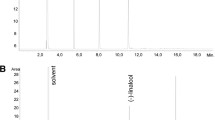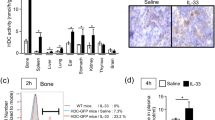Abstract
This study was designed to clarify the important association between eosinophilia-myalgia syndrome (EMS) and thel-tryptophan contaminant, “Peak E.” To determine the functional activation of eosinophils induced by Peak E, eosinophil cationic protein (ECP) release was examined. Peak E augmented the release of ECP from peripheral blood normodense eosinophils by degranulation. Proliferative analysis using the human eosinophilic leukemia cell line EoL-3 showed prominent cellular replication in the presence of Peak E. Moreover, Peak E upregulated interleukin 5 (IL-5) receptor levels on normodense eosinophils. Of particular interest, Peak E-stimulated human splenic T cells produced bipactive and immunoreactive IL-5. Marked induction of IL-5 mRNA in Peak E-stimulated T cells was also shown by reverse-transcriptase polymerase chain reaction (RT-PCR). In contrast,l-tryptophan without the contaminant showed none of these effects. Thus, these data suggest that Peak E might be involved in the pathogenesis of EMS through bimodal mechanism including IL-5 generation by T cells and potentiation of eosinophil functional activation.
Similar content being viewed by others
References
Eosinophilia-myalgia syndrome—New Mexico. Morbid Mortal Week Rep 38:765–767, 1989
Hertzman PA, Blevins WL, Mayer J, Greenfield B, Ting M, Gleich GJ: Association of the eosinophilia-myalgia syndrome with the ingestion of tryptophan. N Engl J Med 322:869–873, 1990
Silver RM, Heyes MP, Maize JC, Quearray B, Vionnet-Fuasset M, Sternberg EM: Scleroderma, fascitis, and eosinophilia associated with the ingestion of tryptophan. N Engl J Med 322:874–881, 1990
Belongia EA, Hedberg CW, Gleich GJ, White KE, Mayeno AN, Loegerings DA, Dunnette SL, Pirie PL, MacDonald KL, Osterholm MT: An investigation of the cause of the eosinophilia-myalgia syndrome associated with tryptophan use. N Engl J Med 323:357–365, 1990
Slutsker L, Hoesly FC, Miller L, Williams LP, Watson JC, Fleming DW: Eosinophilia-myalgia syndrome associated with exposure to tryptophan from a single manufacturer. JAMA 264:213–217, 1990
Mayeno AN, Lin F, Foote CS, Loegering DA, Ames MM, Hedberg CW, Gleich GJ: Characterization of “Peak E” a novel amino acid associated with eosinophilia-myalgia syndrome. Science 250:1707–1708, 1990
Centers for Disease Control (CDC): 1990 Update: analysis of L-tryptophan for the etiology of eosinophilia-myalgia syndrome. Morbid Mortal Week rep 39:789–790, 1990
Crofford LJ, Rader JI, Dalakas MC, Hill RH, Page SW, Needham LL, Brady LS, Heyes MP, Wilder RL, Gold PW, Illa I, Smith C:l-Tryptophan implicated in human eosinophilia-myalgia syndrome causes fascitis and perimyositis in the Lewis rat. J Clin Invest 86:1757–1763, 1990
Love LA, Rader JI, Crofford LJ, Raybourne RB, Principato MA, Page SW, Trucksess MW, Smith MJ, Dugan EM, Turner ML, Zelazowski E, Zelazowski P, Sternberg EM: Pathological and immunological effects of ingestingl-tryptophan and 1,1′-ethylidenebis (l-tryptophan) in Lewis rats. J Clin Invest 91:804–811, 1993
Rothenberg ME, Owen WF, Silberstein DS, Woods J, Soberman RJ, Austen KF, Stevens RL: Human eosinophils have prolonged survival, enhanced functional properties, and become hypodense when exposed to human interleukin 3. J Clin Invest 81:1986–1992, 1988
Owen WF, Rothenberg ME, Silberstein DS, Gasson JC, Stevens RL, Austen KF, Soberman RJ: Regulation of human eosinophil viability, density, and function by granulocyte/macrophage colony-stimulating factor in the presence of 3T3 fibroblasts. J Exp Med 166:129–141, 1987
Rothenberg ME, Petersen J, Stevens RL, Silberstein DS, Mckenzie DT, Austen KF, Owen WF: IL-5-dependent conversion of normodense human eosinophils to the hypodense phenotype uses 3T3 fibroblasts for enhanced viability, accelerated hypodensity, and sustained antibody-dependent cytotoxicity. J Immunol 143:2311–2316, 1989
Lopez AF, Sanderson GJ, Gamble JR, Campbell HD, Young IG, Vadas MA: Recombinant human interleukin 5 is a selective activator of human eosinophil function. J Exp Med 167:219–224, 1988
Clutterbuck EJ, Hirst EM, Sanderson CJ: Human interleukin-5 (IL-5) regulated the production of eosinophils in human bone marrow cultures; Comparison and interaction with IL-1, IL-3, IL-6, and GM-CSF. Blood 73:1504–1512, 1989
Clutterbuck EJ, Sanderson C: Regulation of human eosinophil precursor production by cytokines: A comparison of recombinant human interleukin-1 (rhIL-1), rhIL-3, rhIL-5, rhIL-6, and rh granulocyte-macrophage colony stimulating factor. Blood 75:1774–1779, 1990
Limaye AP, Abrams JS, Silver JE, Ottesen EA, Nutman TB: Regulation of parasite-induced eosinophilia: Selective increased interleukin-5 production in helminth-infected patients. J Exp Med 172:399–402, 1990
Enokihara H, Kajitani H, Nagashima S, Tsunogake S, Takano N, Saito K, Furusawa S, Shishido H, Hitoshi Y, Takatsu K: Interleukin 5 activity in sera from patients with eosinophilia. Br J Haematol 75:458–462, 1990
Coffman RL, Seymour BW, Hudak S, Jackson J, Rennick D: Antibody to interleukin-5 inhibits helminth-induced eosinophilia in mice. Science 245:308–310, 1989
Yamaoka KA, Miyasaka N, Kashiwazaki S:l-tryptophan contaminant “Peak E” and interleukin-5 production from T cells. Lancet 338:1468, 1991
Toyo'oka T, Yamazaki T, Tanimoto T, Sato K, Sato M, Toyoda M, Ishibashi M, Toshihira K, Uchiyama M: Characterization of contaminants in EMS-associatedl-tryptophan samples by high-performance liquid chromatography. Chem Pharm Bull 39:820–822, 1991
Yamaoka KA, Claésson H-E, Rosén A: Leukotriene B4 enhances activation, proliferation, and differentiation of human B lymphocytes. J Immunol 143:1996–2000, 1989
Fukuda Y, Hashino J, Haruyama M, Tsuruoka N, Nakazato H, Nakanishi T: A sandwich enzyme-linked immunosorbent assay for human interleukin-5. J Immunol 143:89–94, 1991
Saito H, Bourinbaiar A, Ginsburg M, Minato K, Ceresi E, Yamada K, Machover D, Breard J, Mathe G: Establishment and characterization of a new human eosinophilic leukemia cell line. Blood 66:1233–1240, 1985
Chomczynski P, Sacchi N: Single-step method of RNA isolation by acid guanidinium thiocyanate-phenol-chloroform extraction. Anal Biochem 162:156–159, 1987
Owen WFJ, Petersen J, Scheff DM, Folkerth RD, Anderson RJ, Corson JM, Sheffer AL, Austen KF: Hypodense eosinophils and interleukin 5 activity in the blood of patients with eosinophilia-myalgia syndrome. Proc Natl Acad Sci USA 87:8647–8651, 1990
Ackerman SJ, Loegering DA, Venge P, Olsson I, Harley JB, Fauci AS, Gleich GJ: Distinctive cationic proteins of the human eosinophil granule: Major basic protein, eosinophil cationic protein, and eosinophil-derived neurotoxin. J Immunol 131:2977–2982, 1983
Owen WF, Rothenberg ME, Petersen J, Weller PF, Silberstein D: Interleukin-5 and phenotypically altered eosinophils in the blood of patients with the idiopathic hypereosinophilic syndrome. J Exp Med 170:343–348, 1989
Lopez AF, To LB, Yang Y-C, Gamble JR, Shannon MF, Burns GF, Dyson PG, Juttner CA, Clark S, Vadas MA: Stimulation of proliferation, differentiation, and function of human cells by primate interleukin 3. Proc Natl Acad Sci USA 84:2761–2765, 1987
Broide DH, Paine MM, Firestein GS: Eosinophils express interleukin 5 and granulocyte macrophage-colony-stimulating factor mRNA at sites of allergic inflammation in asthmatics. J Clin Invest 90:1414–1424, 1992
Chihara J, Plumas J, Gruart V, Tavernier J, Prin L, Capron A, Capron M: Characterization of a receptor for interleukin 5 on human eosinophils: Variable expression and induction by granulocyte/macrophage colony-stimulating factor. J Exp Med 172:1347–1351, 1990
Saito H, Miyamoto T: Peak-E-induced production of granulocyte-macrophage colony-stimulating factor (GM-CSF) in human peripheral blood mononuclear cells.In Proceedings of the Research in Health and Welfare MHW of Japan [Investigation of the causal mechanisms of eosinophilia myalgia syndrome (EMS) associated with L-tryptophan products], 1992, pp 43–49
Barnharter ER, Maggio VL, Alexander LR, Turner WE, Patterson DG, Needham LL: Bacitracin-associated peptides and contaminatedl-tryptophan. Lancet 336:742, 1990
Hibbs JR, Mittleman B, Hill P, Medsger TA:l-Tryptophan-associated eosinophilic fasciitis prior to the 1989 eosinophilia-myalgia syndrome outbreak. Arth Rheum 35:299–303, 1992
Smith B, Prickop DJ: Central-nervous-system effects of ingestion ofl-tryptophan by normal subjects. N Engl J Med 267:1338–1341, 1962
Eastman CL, Guilarte TR: Cytotoxicity of 3-hydroxy kynurenine in a neuronal hybrid cell line. Brain Res 28:225–231, 1989
Sternberg BM, Van Woert MH, Young SN, Magmussen I, Baker H, Gauthier S, Osterland CK: Development of a scleroderma-like illness during therapy withl-5-hydroxytryptophan and carbidopa. N Engl J Med 303:782–787, 1980
Deoliveira JS, Auerbach SB, Sullivan KM, Sale GE: Fatal eosinophilia myalgia syndrome in a marrow transplant patient attributed to toal nutrition with a solution containing tryptophan. Bone Marrow Transplant 11:163–167, 1993
Author information
Authors and Affiliations
Rights and permissions
About this article
Cite this article
Yamaoka, K.A., Miyasaka, N., Inuo, G. et al. 1,1′-Ethylidenebis(tryptophan) (peak E) induces functional activation of human eosinophils and interleukin 5 production from T lymphocytes: Association of eosinophilia-myalgia syndrome with al-tryptophan contaminant. J Clin Immunol 14, 50–60 (1994). https://doi.org/10.1007/BF01541175
Accepted:
Issue Date:
DOI: https://doi.org/10.1007/BF01541175




